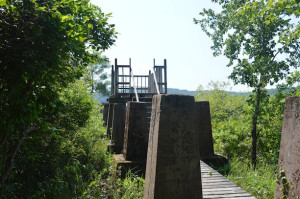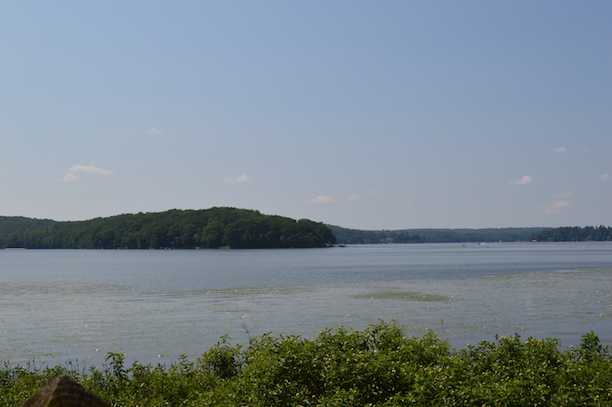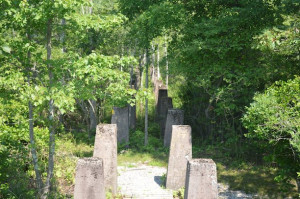by Peter Vermilyea
In the days before refrigerators, foods either needed to be preserved (through canning, smoking, or salting) or kept fresh through the use of ice boxes. Ice boxes depended on a steady supply of fresh ice—no easy proposition in the summer months. To satisfy the demand for blocks of ice, people harvested ice from New England ponds and lakes in the winter (usually in January and February when temperatures were the coldest).

This canal supplied water to the pump house, where it was used to wash away ice chips/shards – Peter Vermilyea
The earliest ice harvests resembled early labor systems used for harvesting crops, with neighbors and friends pitching in and receiving compensation from a share of the crop. Harvesters used specialty tools, including gang saws, chisels, and saw plows to cut the ice into blocks and then transport the blocks to ice houses for keeping. Ice houses contained floors constructed one foot off the ground to allow for the passage of air under the ice. They featured double walls, one foot apart and packed with shavings or saw dust for insulation. The pitched floors of these ice houses allowed for drainage.
Commercial Ice Harvesting
The largest ice harvesting operation in Connecticut was the Berkshire Ice Company (later part of the Southern New England Ice Company) on Bantam Lake. Their facility stood near the present Litchfield Town Beach on North Shore Road in Bantam. Here the foreman’s house and machine shop still stand, and the remains of workers’ dormitories and, most impressively, the 700-foot by 125-foot ice house are visible.
The ice house had fourteen 30-foot-high storage sections that each held 4,000 tons of ice for a total capacity of 56,000 tons of ice. It took 40 harvested acres of ice to fill the warehouse. The particular challenge the workers faced was getting the ice into the storage house. This proved especially difficult because the ice was cut into the 300-pound blocks preferred for wholesale purposes. (Retail ice came in 25-, 50-, or 100-pound blocks).
Workers (who were paid 60 cents an hour and worked seven days a week in the mid 1920s) cut channels into the lake and then utilized poles to float the ice to a ramp on which rested a conveyor belt. Powered by a 100-horse power engine tied to the Bantam Falls power plant, the conveyor belts reached approximately 1000 feet from the lake to the ice house. The concrete pillars of this system still stand as ghostly sentinels in the swampy grounds of White Memorial; today the remaining pillars support an observation tower on the shores of Bantam Lake.
In the summer months, a spur of the Shepaug Valley Railroad ran from the Lake Station (today, the Cove Shops on Route 202) to the ice house, where it split to run parallel, thus allowing workers to fill cars from both sides of the structure. The company filled up to 20 box cars a day with ice and facilitated its transport to locations as far away as Bridgeport. Alain White, in his History of Litchfield, described the “long trains,” which “pull out daily in the summers, carrying concentrated relief from the Litchfield Hills to the larger cities southward.”

This observation tower along the Lake (Yellow) Trail at White Memorial sits at the point where ice was taken out of the lake and sent to the ice house – Peter Vermilyea
The spread of electricity and refrigerators to households in the 1920s led to a severe decline in the demand for harvested ice. On August 8, 1929, a massive fire swept through the Berkshire facility. Some speculated that the spontaneous combustion of either the hay or sawdust at the site caused the fire, while others linked it to several cases of arson in the area. Either way, over $350,000 in damages resulted from the destruction of the ice house building, nine railroad cars, and over 50,000 tons of ice valued at $200,000. The next year the Southern New England Ice Company sold its land to the White Memorial Foundation; as a result, only the buildings’ foundations now remain to remind us of this once vibrant industry.
Peter Vermilyea, who teaches history at Housatonic Valley Regional High School in Falls Village, Connecticut, and at Western Connecticut State University, maintains the Hidden in Plain Sight blog and is the author of Hidden History of Litchfield County (History Press, 2014).
Note: ConnecticutHistory.org does not edit content originally published on another platform and therefore does not update any instances of outdated content or language.









